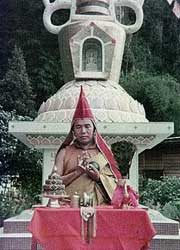Vajarayana Buddhism in Perak caves
By Revathi Murugappan, The Star, April 24, 2010
 |
| Tulku Urgyen Rinpoche consecrating the Vajrayana stupa in 1972 |
Perak is a veritable treasure trove of caves and probably houses the largest number of cave temples in the country, some of which are still inhabited by monks.
Unknown to many, and hidden amidst the overgrown swordgrass that surrounds the limestones of Gunung Rapat in Ipoh, is a stupa that was built and consecrated by Tulku Urgyen Rinpoche in 1972. Its history is hazy but the stupa, adjacent to a cave, is believed to be the first one built in Malaysia in the Vajrayana tradition.
Vajrayana Buddhism is considered the oldest surviving school of Tibetan Buddhism and has thousands of followers locally. The cave, popularly known as Ipoh Cave or the Ipoh Kong Ngee Ngiam Cave Temple, was not accessible to the public until recently when one eager devotee decided to dig deeper to discover how the Vajrayana tradition arrived in Malaysia.
Music teacher Anne Saw, 45, along with other devotees, were cleaning up the place when they stumbled upon a rusty old gate. It was the original entrance to the cave temple. Saw then researched the place, hunted down old disciples and made notes.
Yes, three caretaker monks have lived there for the past 30 years, leaving the premises only to buy groceries or go on retreats. I was privileged to be taken on a tour a fortnight ago by the enthusiastic Saw and was awestruck by the interior.
One of the caretakers, only known as Fong, let us in. It was huge and cool inside, with many bookshelves, figurines of the Buddha and lighted oil lamps. It was a calming space. Some of the walls had been painted white, and young students had done impressive colour paintings on the roof. Go deeper in and you’ll find bat droppings, damp limestone and even lower temperatures.
According to one of Tulku Urgyen’s old disciples, Yeow Yow Kit, 68, the lama used to come here frequently to meditate. He loved the place for some reason and felt a strong connection, staying a few months at a time.
“The cave temple was founded by a Chinese Mahayana monk, Rev Seng Chun from Foo Chow, China before World War II. In those years, it was a retreat for serious Buddhist practitioners, especially nuns. During the communist insurgency, the monks and nuns were told to leave,” recalled Yeow, 68.
Then in the early 1960s, Yeow said, a local monk named Rev Yuen Thong took up residence. He improved the living conditions and was instrumental in propagating Buddhist activities in Ipoh. Then, in 1971, he invited Tulku Urgyen to Ipoh. Tulku accepted and came with an attendant who spoke a bit of Malay. They took a train from Kathmandu to Bangkok, and then on to Ipoh and found their way to the cave.
“Despite the language and cultural disadvantages, the Buddhist seeds were planted through the activities in the cave, and subsequently this brought about more visitations from other lamas,” Yeow said.
“Apparently, whenever Tulku Urgyen met Malaysians, he would ask: Have you been to Ipoh Cave?”
He was so inspired that he also wrote a lot of preliminary text in this cave and took them back to be translated into English. Western disciples then expanded on it.”
In 1981, Tulku Urgyen and his eldest son, Chokyi Nyima Rinpoche, embarked on their first world tour to spread Buddhist teachings. Along the way, they stopped at Ipoh Cave, where like his father, Choyki Nyima felt an immediate connection.
“The cave has good feng shui because many holy teachers meditated and gave initiation there. I can feel the power, blessings and positive energy emanating from the place,” said Chokyi Nyima, now abbot of the Ka-Nying Shedrub Monastery in Nepal. Chokyi Nyima, 59, is in town for a series of lectures.
The cave was unfortunately neglected when Tulku Urgyen passed away in 1996. However, restoration works are now being planned by devotees. To invoke the blessings of the stupa, Choyki Nyima will conduct a one-day meditation at the cave. Until restoration is carried out, Saw says the public may only visit the cave during special events
“Strangely, after Tulku Urgyen died, the monastery people couldn’t find his reincarnation although they searched everywhere. He left no clues. Usually, the reincarnation is found in three or four years. Then one lama suggested visiting all the caves he had gone to, and right after the group visited Ipoh Cave in 2005, they got word that the reincarnation was found somewhere in Nepal. He was nine years old.”
Since then, Chokyi Nyima has been coming here regularly, albeit quietly, to meditate and conduct prayer sessions. He was born in Tibet and at 18 months was identified as the seventh reincarnation of the Drikung Kagyu Lama.
The eight-year-old and his family fled to Nepal when the Chinese invaded Tibet in 1959. Since then, he has studied in monasteries and schools in India and Nepal.
“I just know my path is the right one and don’t think too much about it. I go on teaching and preaching in universities all over the world but I have no degree!” joked ChokyiNyima who founded the Rangjung Yeshe Institute for Buddhist Studies in Nepal.
Source: http://www.buddhistchannel.tv
